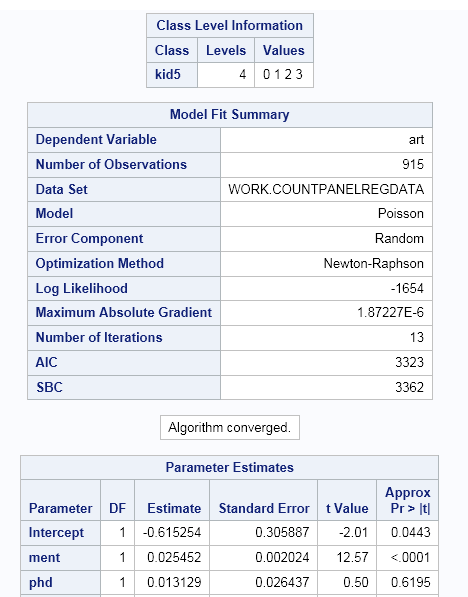Panel Data: Count Data Regression Task
About the Panel Data: Count Data Regression Task
The Panel Data: Count
Data Regression task performs count data regression of a continuous
dependent variable. This variable is a nonnegative integer value from
Poisson or negative binomial distributed panel data.
Note: This task is available only
if you are running the first maintenance release for SAS 9.4 (or later)
and SAS/ETS 13.1 (or later).
Example: Count Data Regression with Panel Data
To create this example:
-
Create the WORK.LONG97DATA data set. For more information, see LONG97DATA Data Set.
Assigning Data to Roles
To run the Count Panel
Data Regression task, you must assign columns to the Dependent
variable and Cross-sectional ID roles.
|
Role
|
Description
|
|---|---|
|
Dependent
variable
|
specifies the numeric
column that has nonnegative integer or count values.
The Distribution option
specifies the type of model to be analyzed. You can specify these
types of models:
|
|
Continuous
variables
|
specifies the independent
covariates (regressors) for the regression model. If you do not specify
a continuous variable, the task fits a model that contains only an
intercept.
|
|
Categorical
variables
|
specifies the variables
to use to group data in the analysis.
|
|
Cross-sectional
ID
|
specifies the cross-section
for each observation. You can specify whether the error component
model is fixed or random.
|
Setting Options
|
Option
|
Description
|
|---|---|
|
Methods
|
|
|
Type of
covariances of the parameter estimates
|
specifies the type of
covariance matrix of the parameter estimates.
You can specify these
types of matrices:
|
|
Include
the intercept in the model
|
specifies whether to
include the intercept in the model.
|
|
Optimization
|
|
|
Method
|
specifies the iterative
minimization method to use.
|
|
Maximum
number of iterations
|
specifies the maximum
number of iterations for the selected method.
|
|
Statistics
|
|
|
You can specify whether
to include the statistics that the task creates by default and any
additional output tables in the results.
Here are the additional
statistics that you can include in the results:
|
|
Copyright © SAS Institute Inc. All rights reserved.

